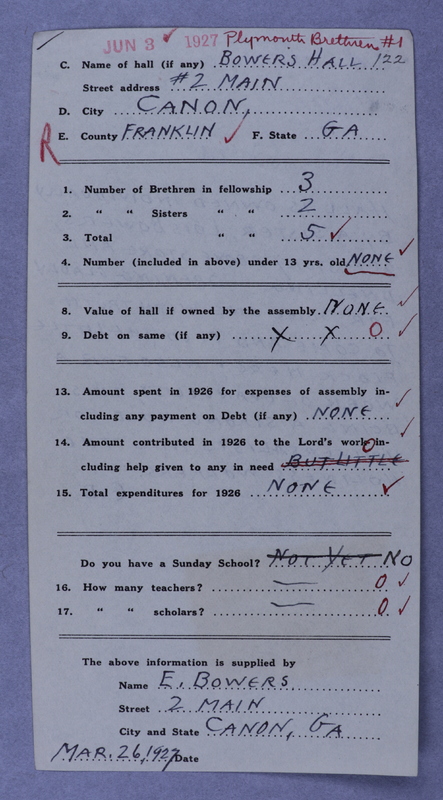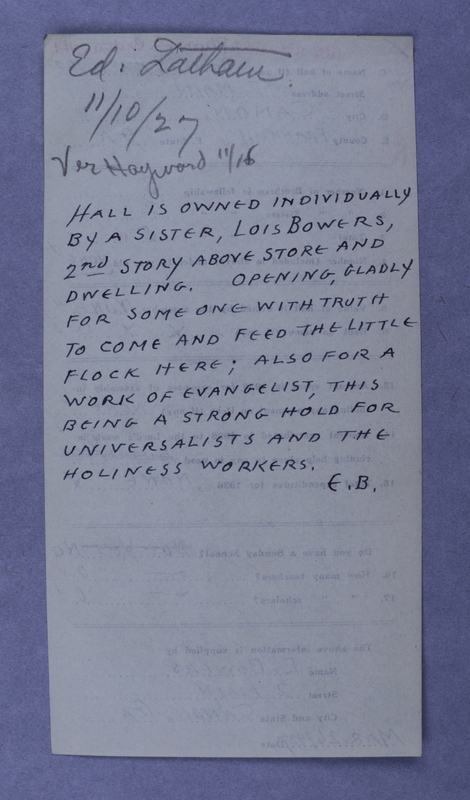Schedule Spotlight: Plymouth Brethren I: 122
As we’ve written about before in other blog posts at Religious Ecologies, seeing women’s names documented in Census schedules is rare - and therefore, worth noting. Though many denominations documented more female members than male, the pastor names are often men’s names, and few other names appear on the schedule. However, in this specific schedule, the person who filled out the information added a note on the back of the piece of paper. With this note, we get the name of an important woman in a Plymouth Brethren congregation in a small town in Georgia, Lois Bowers. With her name, we can learn more about her, as well as the Plymouth Brethren.
In the early nineteenth century, John Nelson Darby, a strict Calvinist and premillennialist, helped found the Plymouth Brethren denomination. Darby, an Anglo-Irish clergyman, broke from the Church of Ireland after serving as a country curate, and his Plymouth Brethren grew as a separatist movement in Ireland and Britain, and later in continental Europe. A further split in 1848 formed the Open and Exclusive Brethren, and the Plymouth Brethren are part of the Open Brethren tradition. The name Plymouth Brethren came from a meeting formed in Plymouth, England in 1831, which Darby attended. Darby emphasized a separation of the Brethren from society and worldly activities. Darby traveled to North America in the 1860s and 1870s, bringing along his dispensational premillennialism beliefs. Other emigrant Plymouth Brethren further established the movement in the United States in following decades.
Though they have no official ecclesiastical organization, clergy, or doctrinal creed, all Plymouth Brethren place emphasis on Scripture, the salvation of all believers, and prophecies. Evangelization and missionary work is important to the Plymouth Brethren, as shown by their international presence, with over 50,000 members across the United Kingdom, Europe, the Americas, Australia, and New Zealand today.
The Census Bureau listed six different bodies of the Plymouth Brethren movement in the 1926 Census, and the schedule we are focusing on include a congregation listed as part of the Plymouth Brethren I. According to the Census Bureau’s categorization, Plymouth Brethren I is the more conservative sect of the Plymouth Brethren, but this categorization is the Census Bureau’s own. In fact, the Census Bureau wrote in published records that the “Roman numerals are used for the sake of distinction, but they do not imply any precedence in chronological order or strength of membership; they simply indicate the order in which the different bodies came to the knowledge of the Bureau of the Census.”1 The Plymouth Brethren do not use this categorization themselves, but we will use it since we are working with Census data from schedules.

Figure 1. Schedule from Bowers Hall in Canon, Georgia.
Bower’s Hall was a Plymouth Brethren I congregation located at 2 Main Street in Franklin, Georgia as of June 3, 1927. The schedule shows that the congregation had five members, two women and three men, no expenses or debt, and no Sunday School. But the interesting part of the schedule is on the pack of the form. A handwritten note reads “Hall is owned individually by a Sister, Lois Bowers, 2nd story above store and dwelling. Opening, gladly for someone with truth to come and feed the little flock here; also for a work of evangelist, this being a strong hold for Universalists and the Holiness Workers. E.B.” It is also interesting to note that the schedules used for the Plymouth Brethren differed from those used throughout the 1926 Religious Census, and was noticeably shorter.

Figure 2. Back of schedule for Bowers Hall in Canon, Georgia. Handwritten note signed by E. B(owers). The note includes information about Sister Lois Bowers, the dwelling used by the congregation, and a desire for an evangelist to come to Canon.
Sister Lois Bowers owned the meeting place and gave her name to the congregation. The ownership of the place is surprising because of the gendered aspects of property rights, but also because “[w]omen take no part in public ministry,” though there are no clergy and anyone can preside over meetings.2 Lois Bowers was listed in the 1930 US Census as a single, white woman born in Georgia in 1869. Therefore, in 1927 she would have been around 58 years old. Though the census lists her household as having included her brother, Ezrie or Ezra Bowers, she was documented as the head of the household, though her brother’s age was 66 to her 61.3 Since Ezrie lived with Lois, there’s a chance he was also a member of the Plymouth Brethren of Bowers Hall (especially since the schedule was filled out by E. Bowers and the additional note on the back of the form was also signed by E.B.).
Sister Bowers’ ownership of her own house and her designation as head of household - despite an older brother at home - bucks expected gender norms of the early 20th century. The use of her name for the Hall further suggests that women could have an important role in Plymouth Brethren congregations, at least if they could provide financial support. This additional note and the inclusion of a woman’s name provide a unique window into a congregation of a small Christian movement.
Religious Bodies: 1926, Department of Commerce, Bureau of the Census (Government Printing Office, 1930), 1: 257. ↩︎
Religious Bodies: 1926, Department of Commerce, Bureau of the Census (Government Printing Office, 1930), 2: 257. ↩︎
“United States Census, 1930,” database with images, FamilySearch (https://www.familysearch.org/ark:/61903/1:1:3Q48-X6Z : accessed 5 August 2021), Lois Bowers, District 1363, Franklin, Georgia, United States; citing enumeration district (ED) ED 15, sheet , line , family , NARA microfilm publication T626 (Washington D.C.: National Archives and Records Administration, 2002), roll ; FHL microfilm . ↩︎
